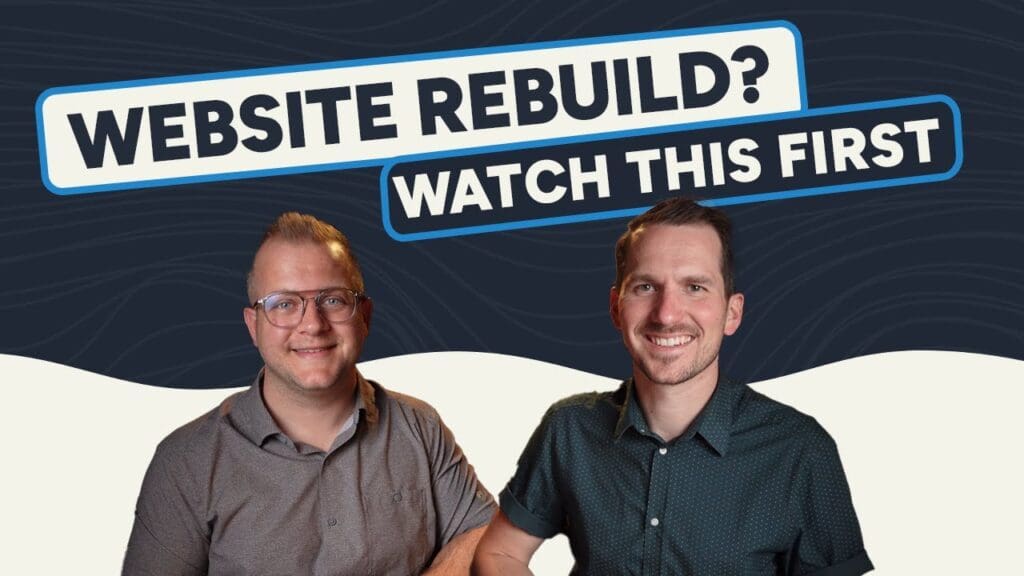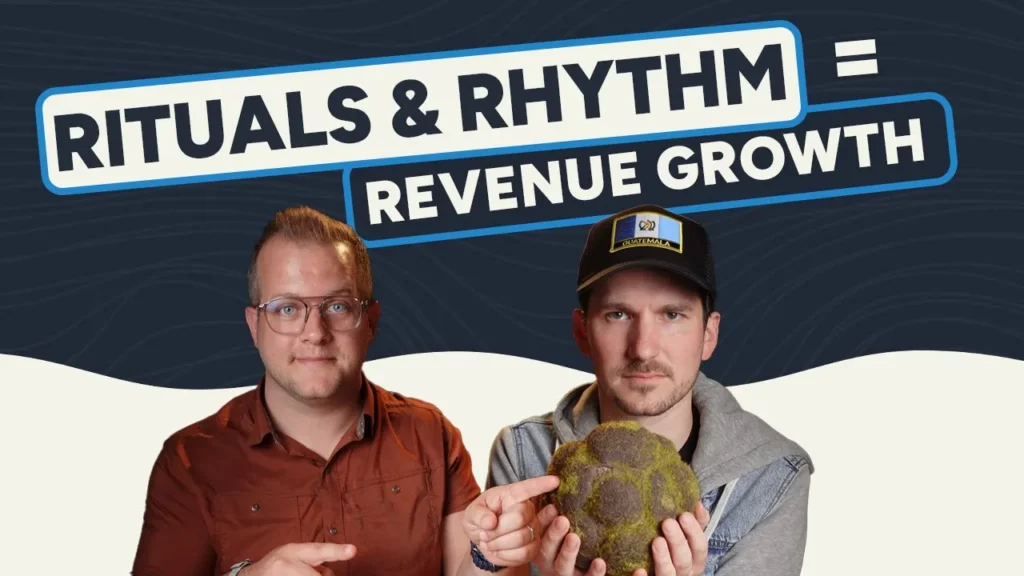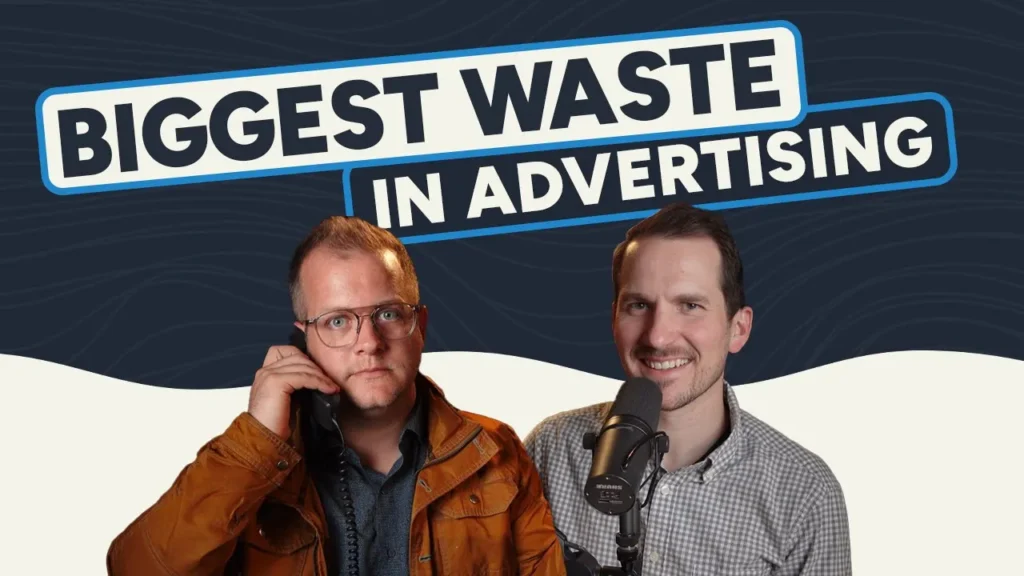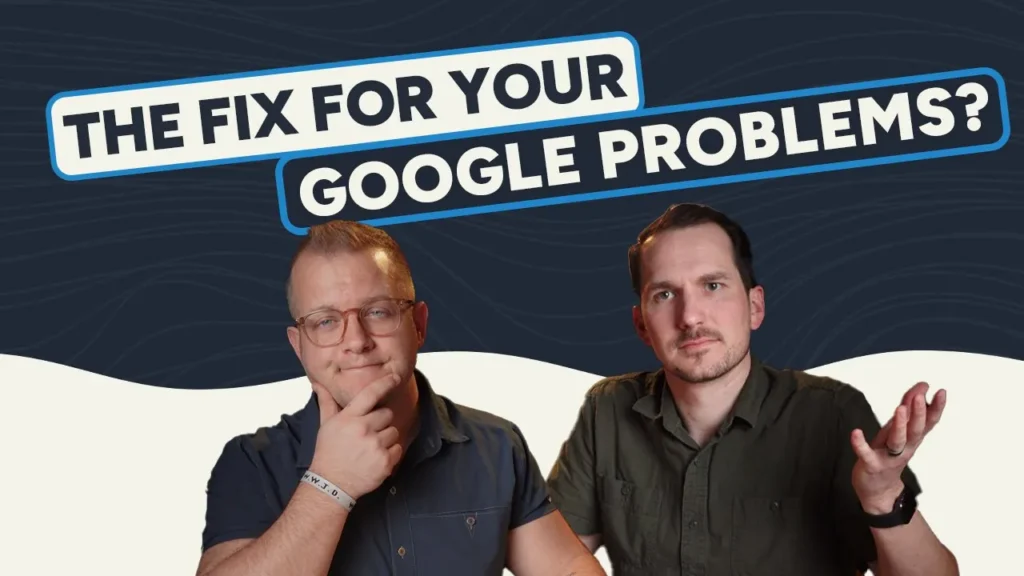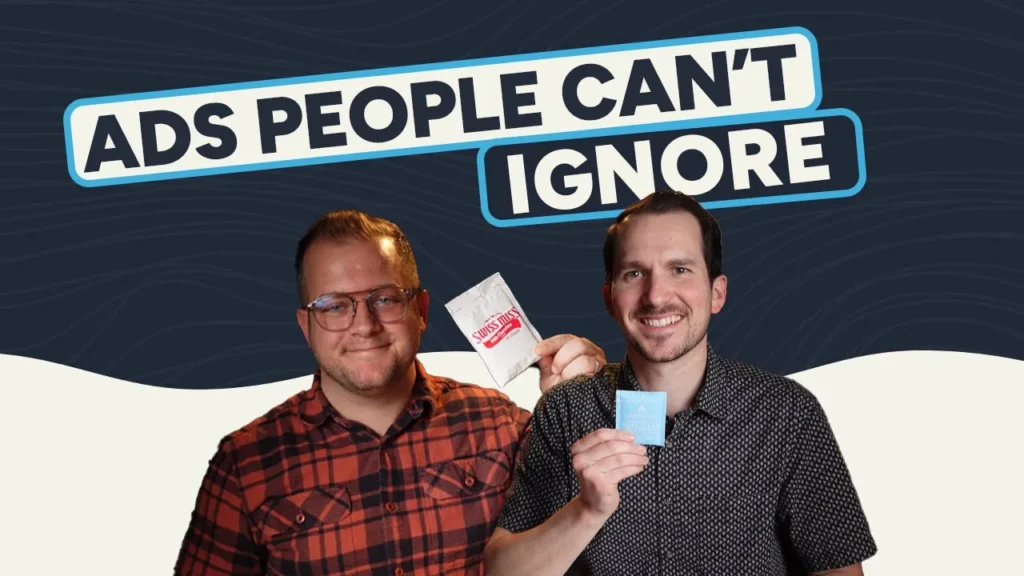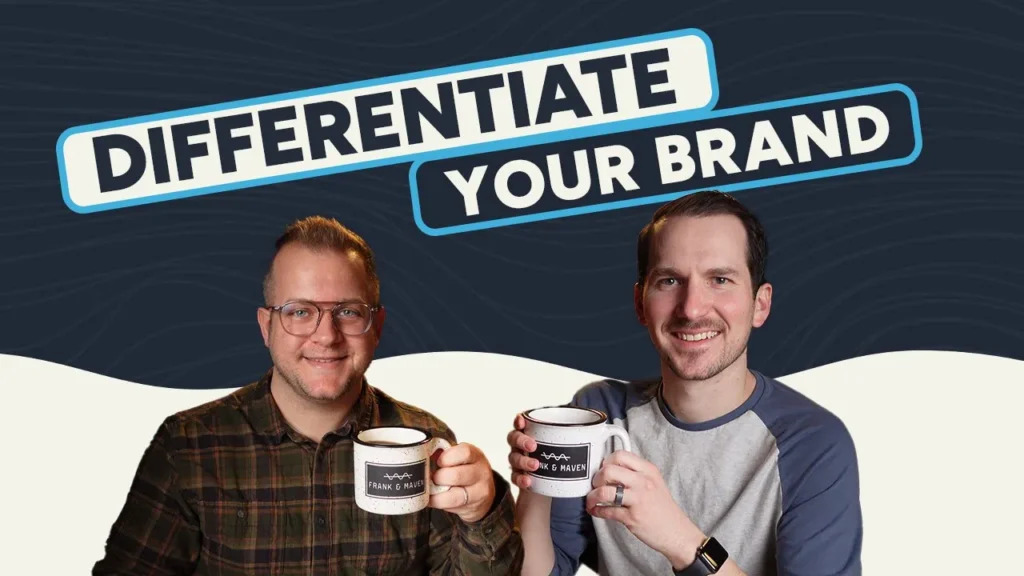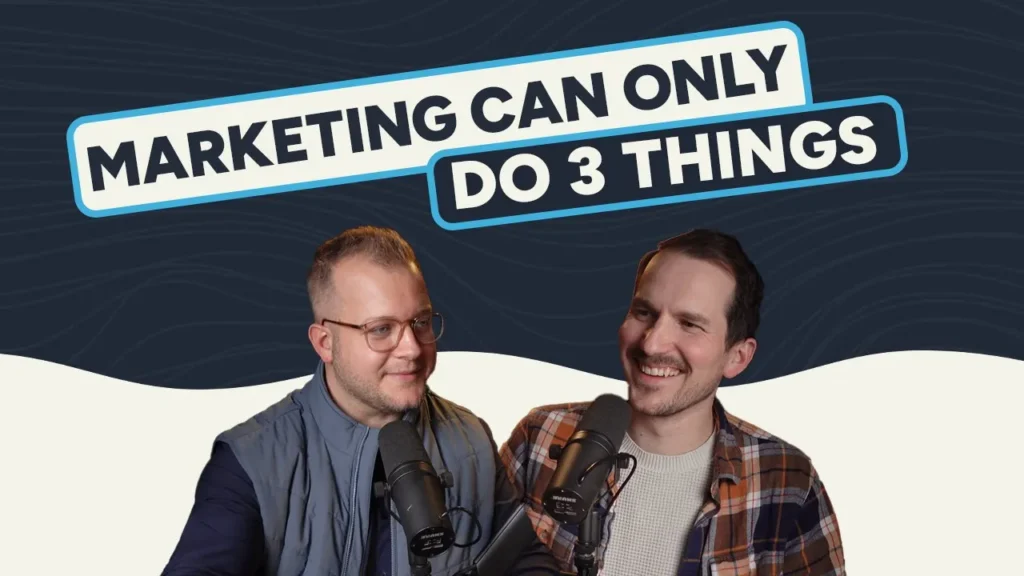How to Know If You Need A New Website

Your website is the salesman that never sleeps.
What has he done for you lately?
Today we share 7 performance indicators you can use to determine if your site is putting up the numbers that it should, or if it’s time to make some changes.
This knowledge will make (and save) you big bucks!
00:00 Intro
01:20 The Biggest Source of Advertising Waste
02:36 Is Your Conversion Rate Costing You Money?
06:39 A Big Culprit of Poor SEO and Lead Generation
09:23 How to Prevent Getting Hacked
13:18 Are People Leaving Your Site Within Seconds?
17:57 What Happens When Your Content Is Out of Whack
21:16 What Bad Design Says About Your Company
25:14 The Cost of Poor Search Engine Ranking
26:46 Recap
27:09 The Price Is Right
This Episode Hosted by:
Recent Episodes:
Rituals & Rhythm = Revenue Growth
The Single Biggest Waste In Advertising
Get New Episodes In Your Inbox:
We'll be back every Monday answering your real life marketing questions!
Listen to Audio Only:
Keep Sharpening Your Marketing Skills With The Maven Marketing Podcast
Rituals & Rhythm = Revenue Growth
Culture eats strategy for breakfast—and in this episode, Brandon Welch and Caleb Agee show you why rhythm…
The Single Biggest Waste In Advertising
You might think the biggest waste in advertising is bad creative, weak targeting, or outdated platforms. But…
IDKWNTHTB – Keep Showing Up!
Every business owner hits the wall. You launch the campaign, tweak the copy, show up every week—and…
Stop asking, “How did you hear about us?” (do this instead)
It’s lurking… tucked into a form on your website or maybe it’s a part of your sales…
IDK Who Needs To Hear This But: You Need To Fill One Glass At A Time
FREE MARKETING AUDIT: MavenMarketingAudit.com Get a copy of our Best-Selling Book, The Maven Marketer Here: https://a.co/d/1clpm8a Our…
How to Immediately Differentiate Your Brand
There are no more unique value propositions. You could invent the next big thing and you’ll have…
Marketing Can Only Do 3 Things
We can get distracted by all the activities and actions associated with marketing. Still, when it comes…
Brandon Welch 0:00
Your website is the salesman that ever sleeps, and so is that salesman producing confidence? Is that salesman doing the things that it needs to do to get people from interested to buying?
Welcome to the Maven Marketing Podcast. Today is Maven Monday. I’m your host, Brandon Welch, and I’m joined by my co host Caleb. Fancy t shirt. AG, where’d you get that fancy t shirt?
Caleb Agee 0:27
I got it from this place called the Maven Marketing podcast. We
Brandon Welch 0:30
are giving away fancy T shirts. You ask a question this week about your business. Bonus one, you get your question answer for your business. You got some growth advice?
Caleb Agee 0:40
Yeah, million dollar ideas.
Brandon Welch 0:42
Cherry on top, we’ll send you a fancy t shirt. Make sure you include your size. Where do they send those questions? Maven
Caleb Agee 0:46
Monday at frankan. Maven.com
Brandon Welch 0:48
Send us your real life marketing questions, because this is the place where we answer those real life marketing questions so you can eliminate waste in advertising, grow your business and achieve the big dream. And today, we are honing in on that wasted advertising part. Yes, we hate wasted advertising. We
Unknown Speaker 1:05
hate it. Nate, Why
Brandon Welch 1:06
do we exist to help entrepreneurs
Unknown Speaker 1:07
confidently grow their business without wasting money on advertising? That is
Brandon Welch 1:11
why we exist. We say it every single week. That’s how we start our week. That’s how we start our meetings. If you know that, you know that, if you’re a frank and Maven peep, but one of the biggest sources of wasted advertising is your website. It’s kind of the funnel where it all, all the rubber hits the road, everything
Caleb Agee 1:28
points, all roads lead to not Rome, your website, your
Brandon Welch 1:33
website. And if you are unprofitable there, meaning if you’re not doing the right things there, it can literally be the gatekeeper of millions of dollars in business? Yeah, we’ve often made huge impacts in a company just by changing a few things on a website, maybe not even a whole one, but yeah, so today is like just a leveling episode. Be like some people may be trying to sell you a website and you don’t actually need one. Some some people may be not trying to sell you a website. You should find one of those people, and we’re gonna give you seven, like objective things. Just check boxes to go through and say, Are you in a position where you need a new site? Do I need a new one? Yeah, so pretty simple. I see us using this episode to send a lot of people that reach out to us about new websites. Yeah, right. Because a lot of times, because we are so hell bent on not wasting money on advertising, we will say you actually don’t need a new website. Yeah, you may want one, and that’s a different story, but you don’t actually need one. We can make the one you have work better. So there’s seven things, and we’re just going to jump right into
Caleb Agee 2:35
those. Yeah, first one is conversion rate. Yeah, that is, we want to know whether or not your website actually makes, hey, we call the conversion rate. Usually conversions on a website look like form fills calls. If you have an e commerce website, that would be purchases, or if you do tourism, that’d be bookings, you know, all of those kinds of things, right? And we want to know whether or not, when people go to that website, are they taking an action, yes, otherwise, are they taking the next step? Otherwise, you’ve handed them a brochure, yes, that they’re going to throw in the trash can. How would somebody
Brandon Welch 3:11
know if their conversion rate was good or bad, or what it even is? Uh,
Caleb Agee 3:16
you would use Google Analytics. Or if you’re using paid paid traffic, you can go to Google ads and check your conversion rate. There good conversion rate would be 5% would it would be where we would say you could probably baseline work it up to 5%
Brandon Welch 3:34
Yeah, you can certainly have more. We have sites with 30, 40% conversion rate, but a lot of people are surprised when I tell them, like, hey, 5% is decent for, like, a service website. They’re going, I’m only getting 5% of my traffic converting. And it’s like, yeah, yeah. I mean, usually, like, that’s, that’s, I wouldn’t call that good. I would call that Okay, right? Most of the sites that we inherit or come to us from somebody else or somebody who wasn’t paying attention are in like, the 1% Yeah, one to two, yep. And so the analytics tools will tell you this. You don’t but you don’t have to be a super nerd to figure this out. It’s basic math. You’re taking the amount of conversions you’ve had, which, for most people, is a form fill, like, yeah, some sort of contact form, or a phone call, which you can track phone calls with call rail or Google has some basic call tracking, Big 10, yeah. And you just divide how many conversions you got, yeah, into the total number of visits you got, yeah.
Caleb Agee 4:31
So if you didn’t have any tracking set up, you could literally go to your website, export all the submissions on your forms. I had, you know, 10 submissions, and then you can see how many visitors you had. 10
Brandon Welch 4:45
submissions with 100 visits would be a 10% conversion rate, yep, 10 submissions with a 200 visits would be a 5% conversion rate, right? You got it so, if so that that’s what a conversion rate is. But if you’re below. Cool. I’m gonna say, if you’re below 5% you definitely have an opportunity for improvement. That’s yes, that could be a lot, lot higher for some businesses, e commerce, you, I mean, you’d want it to be even a little bit higher than that as your baseline. But,
Caleb Agee 5:13
and I’ll say there’s a nuance on here, because with conversion rates, specifically that alone, I wouldn’t say, says, throw out the whole website. We need a new one. This may mean that it’s just, yeah, it’s a signal. We’re looking at more of the whole picture. We have seven points to look at here. Conversion rate may be able to be updated, fixed with some adjustments, with
Brandon Welch 5:34
better copy, better copy, better social proof, better testimonials, better Landing Page Speed
Caleb Agee 5:40
more access to the conversion action. The form is high on the page, or it’s available, the
Brandon Welch 5:45
form is clear. Like a lot of times, a form that says Contact Us takes you to some random page and there’s nothing on that page producing confidence and reassuring you what’s going to happen on the other side of that form, sometimes just clarifying and making the form language more customer centric will help
Caleb Agee 6:04
a ton, a really powerful we don’t always call these conversions, but another action that people can take is chat. I’m not going to get on the side. Would chase that rabbit for a second, but chat can be a really powerful conversion. Yeah, yes,
Brandon Welch 6:17
because people may not be ready to fill out a form, but they would start a conversation with you, yep. So check your conversion rate. If it’s below 5% you undoubtedly have a opportunity. I’m gonna say, if it’s in the one to 2% it could be a signal of some really bad things wrong. If it’s just floating in that, you know, four to 6% probably some messaging tweaks would fix it. Yeah. But let’s talk about the next thing which could affect conversion rate. Yes, and that would be load speeds, just the overall speed and usability of your website.
Caleb Agee 6:49
Yep. So we like to use a tool called GT metrics. So that’s metrics with an x. We’ll put
Brandon Welch 6:56
the link in the comments. You can where you’re also going to leave a comment right? Leave us a comment while you’re looking at the yeah comments. Comment
Caleb Agee 7:02
with your GT metrics, paid page speed score.
Brandon Welch 7:06
Oh, yeah. And we’ll get you teachers. We’ll
Caleb Agee 7:08
help you out. Yeah, okay. So what they do is they take there’s, you know, Google has their own, and there are some others out on the internet that help grade and speed your website. We want to go to GT metrics because they look at multiples at the same time, instead of getting a one biased opinion, yes.
Brandon Welch 7:28
So you’re gonna go to that GT metrics with an x.com put in your website score. It’s gonna take about eight seconds, and it’s gonna spit out all, like a grade, like an ABCD or F grade, yeah. And then it’s gonna tell you why something’s bad. Sometimes it’s just a technical thing. You can call up your website nerd Yep, they can fix a lot of times it’s going to point to like, there’s so many things overwhelmingly slow or bad from like the server side or the coding side of the website, the true nerd stuff, yeah, that it’s going to start to make sense to consider a total rebuild, because a lot of that’s just structure and server base. So yeah, it’s a case by case basis, but your first step in knowing, hey, how am I performing? Here is go to gtmetrix.com, put your website in, and it’ll give you some scores and all the things that are wrong, if they are wrong, yes, and you’ll know kind of where you stand on
Caleb Agee 8:17
that. And the cool thing it’ll show you that’s really interesting is it’ll show you the first when the users first see something, might be one second in, but then it’ll also talk about the full content and how long that takes to load. And what you find a lot of times is that first second they see something, but it takes 12 seconds, 20 seconds, to load everything. That’s a little bit of a danger zone.
Brandon Welch 8:41
That’s where it really starts affecting your conversion rate, because, like it or not, people are impatient, and especially if it’s from a paid traffic and it’s a service they’re trying to get quick action on. Just a poor user experience just adds to a negative first impression of your brand. And it’s not like, they’re gonna, like, maybe even compute that like, and say, Ooh, this is a slow website. You know, the heck with you guys. I’m not using you. But really, like, the tolerance is less than a minute for somebody to be looking for what they want. It’s, there’s a lot of lot of one liners of what it is, but it’s certainly in like, the 10 to 22nd range. And so if the stuff’s just not loading, it’s just like, man, Back button click the next website that loads fast. So, yep, that’s a big one that leads us
Caleb Agee 9:23
right, right into your tech. So your website, the technology that supports it, severely affects your page speed. It affects the user experience. This is the backbone of the whole thing. So I
Brandon Welch 9:36
like to use the example of iPhones. Yeah. How long do you hold on to an iPhone? I mean, Caleb is a very,
Caleb Agee 9:44
I’m a laggard. He’s a laggard on the on the scale, on the early iPhone had a button till, like, a year ago. Yeah, but yeah, Caleb’s kind
Brandon Welch 9:51
of defined the technology. But most people would agree with an analogy. Every, every couple of years, you’re going, Okay, I know it’s outdated, and then the. Hackers maybe hold on to that device three or four years that’s technology. That’s the speed of technology, right? And it’s not sometimes it’s not just because we want the newest, fanciest thing. That’s a bad reason to do a website. In a lot of cases, yeah, it’s literally the world around it, and the websites and the apps and the softwares update around it so much that that device becomes inept at participating with the newest technology, yes, in the website world, that is things like Google Chrome and Safari, and as those update themselves for security, and for some like, you know, user experience type things, if your website was built on old technology, and the threshold is probably four or five years, like, yeah, you’re way behind the times from what modern website browsers, how it renders your site, and things like that, so the experience is going to be poor, yeah,
Caleb Agee 10:47
so you want to pay attention if you’re if you’re on some sort of like CMS, similar to WordPress, is a common one. We use a lot. We love WordPress, but you got to make sure that your WordPress itself is updated. PHP on your server is updated. You’ve got to make sure your themes are updated, your plugins are updated, because any of those being behind the times can cause your website to load slow or have a security vulnerability, which is also dangerous, because you don’t want bots getting in there and trying to hack stuff. Yeah, yeah. I’m not trying to scare you. Don’t want
Brandon Welch 11:21
to get bought, bought and paid for. Yeah. Paid for. Yeah. I mean, honestly, that happens sometimes we, we have had some websites we’ve built that just aren’t people we talk to often anymore. And like, seven or eight years goes by and, like, they’ll call us and be like, my website is totally nuked and like, the Russians got control of it. And I’m like, Yeah, I mean, I’m sorry. It’s not, it wasn’t necessarily our responsibility to do that. We will help them get out of that situation. But a lot of times, like, if it’s any key piece of your business at all, you can get it hijacked. And generally speaking, if you keep it up to date, if you got somebody doing regular maintenance on it, or at the point of four or five years, you update it and give it, you know, the newest, latest security features. Yeah, you’re gonna prevent yourself from that. Yeah, a lot of times, security is baked in the way
Caleb Agee 12:07
your site was built, you know, three years ago, that theme that it was built on, sometimes the developers aren’t adding or updating that theme, so WordPress moves forward, and your website probably automatically updates with WordPress, but the theme is stuck. Yeah, two years ago, and so it’s just like that new iPhone, but you have the old OS on it. It’s going to be slower than it could have been. It’s going to be less sound than it could have been. If you’re on something like Squarespace or Wix. This is managed for you. I could talk about the pros and cons of those, but
Brandon Welch 12:41
they keep it up to date for you. The website builders that you pay a monthly fee to, the self builders, right? Yeah, which are going to generally be your simpler websites. They’re not going to have custom functionality or custom branding a lot of times on them. The Pro of that, though, is that you’re not messing with server stuff and the nerdy stuff that can really cause you problems if you’re just not maintaining it. So even
Caleb Agee 13:01
like Shopify, some of those. So Shopify, Wix,
Brandon Welch 13:06
Squarespace, all those sites are gonna do that for you. Yep. So content out of whack. That’s number five. Just Just a quick recap. We’ve talked about conversion rate, we’ve talked about load speed, we’ve talked about tech. We’re actually gonna talk about bounce right now is number four, yeah. Tell us about a bounce rate. Caleb, what is
Caleb Agee 13:24
Yeah? So bounce rate, actually, it was interesting when Google changed to GA four last year. In case you didn’t know, Google had an old analytics, Universal Analytics, and then they switched it to GA four, which they forced everybody to go to, yeah. They stopped serving the old one in June of last year, I think it was on GA four. They kind of flipped this on its head, and they said, What is an engaged user, which actually like better than a bounce rate. But the more typical way of talking about is bounce rate, that is somebody comes to your website and leaves without really taking an action, yes, or showing in any sort of intent to browse the
Brandon Welch 14:05
website. Google can tell when they’ve done that, yes, Google Analytics can tell when they’ve done that,
Caleb Agee 14:09
yeah. And so if you have Analytics installed, Google’s gonna count an engagement as staying there longer than 10 seconds, or interacting with an action on the page. So they fill out a form, or they have some sort of conversion point, or they browse to other pages, yes. So if they don’t do those three things, they’ve bounced Yes.
Brandon Welch 14:30
In the industry, just generally, 40% or less is considered kind of okay. Like, if you’re, if you’re 20% or less, you’re like, really, really good, right? Bouncers of a bounce rate, right? Yes. So they’re kind of bounces, measuring how many people leave. So if 20% of your people, 20 to 40% leave, like without taking an action, that’s actually fairly decent, that’s average, right? Yeah, anything lower than that, you got problems, you got opportunities. It’s telling you, hey. If people aren’t finding what they’re looking for, or you weren’t otherwise appealing. So right now, in GA four, if you’re going in there, you’re going to click the Users tab, the acquisition tab, and it’s going to bring up all of your sources, and it’s going to tell you there’s a column that is called engagement rate. And if that’s not 60% or greater you. That’s a signal that something could be improved pretty drastically.
Caleb Agee 15:26
Yeah, and that, what that speaks to is whether or not what you show them probably even above the fold. What do they see first? Because, literally, it’s 10 seconds. That’s all we need to keep them for to be an engaged user. If what’s above the fold doesn’t catch their attention and draw them in and cause them to scroll down or do something or browse around, then you have not spoken to the need that they arrived with. This
Brandon Welch 15:55
plays so much into conversion rate. So yeah, once you think for a second your conversion rate, and all of these things we’re talking about. The performance of your website is the metabolism of your of your marketing. The performance of your website is the metabolism of your marketing. You can put a bunch of, bunch of bunch of visitors in and get, you know, really bad results from that, if you’re using the analogy of food and nutrition, or you with a good metabolism or a good conversion rate, you can put a bunch of calories in and they get burned and turned into good things for you, right? Yep. So you want these four things so far like that is a complete leverage of your entire profitability of your marketing, doubling your conversion rate, cuts in half your cost per acquisition of a customer.
Caleb Agee 16:43
Yeah. Well, think about what we just said with especially considering, I know we spread these out, but conversion rate and bounce rate, if you have 100 visitors, the industry says it’s good if 60 of them don’t just leave. We’re expecting 40. We’re not hoping that 40 leave, but you can, you can reasonably say you have a good website if 60 of them don’t leave in
Brandon Welch 17:06
10 seconds, yes. And then what are those 60 do? Right? And then yeah. And then
Caleb Agee 17:09
the rest, we have 5% conversion rate that we’re calling good. So you think about the numbers you’re stacking and the metrics that it takes to get action to happen, yeah. What
Brandon Welch 17:20
if you got 10 instead of five to take the next step? Like, yeah. And by the way, that’s what we do. That’s a huge thing. FM comes in and does when we inherit a client, they may be coming to us because they think they want more Facebook ads or better TV ads, or they like our video production, but we’re like, Hey, what’s your website doing? We almost always find an opportunity to instantly increase profitability of what they’re already doing, yeah. So if you want to do more with less, if you want to get more return on your advertising investment, your conversion rate and the performance of the metrics or the performance of the pages that get them to the next step is a huge, huge leverage point.
Caleb Agee 17:56
Yeah, yep. So
Brandon Welch 17:57
now we’re going to get to some things that are maybe preference based, yeah, little and confidence in the brand, right? Hey, we’re
Caleb Agee 18:05
taking a quick break from the episode to let you know that Brandon’s best selling book, the Maven marketer, is available on Amazon in both paperback and now hardback. So if you want to grab a copy, this is our playbook for everything that we talk about here on the podcast, and it tells stories of small business owners who have gone through the same struggles you have and how they’ve overcome and stopped wasting money on advertising. You can grab a copy by searching for the Maven marketer on Amazon, or you can click the link in the show notes below. Now back to the episode.
Brandon Welch 18:37
So number five is content out of whack? Yeah.
Caleb Agee 18:40
So we’ve had, we’ve had sites that had ballooned up, and, hear me, they did not need to be ballooned up to over 300 pages on a single website. Yes. And our job, when we took that site, is to ask, we go to strategy first. That’s how we work, the Maven method. Why do we need this? You know, what are we trying to make happen? And we decided this was actually a college, yeah? And we decided their website should be there. There’s a portal for students. There’s all this other stuff. And a lot of that content was made by department heads that just made the
Brandon Welch 19:17
site clunky. Yeah? It made it unclear. People didn’t, yeah, people could have landed on random pages that weren’t even accurate anymore. The
Caleb Agee 19:24
goal of that of their website is student acquisition. It’s a marketing tool. And we said, hey, if it doesn’t have to do with that, we’re going to trim the fat a little bit. We got that down to 110 and I
Brandon Welch 19:35
remember that particular site went up like four or 500% in conversion rate. Yeah, because getting four to five times the student opportunities as it was before, and like, one student was worth the cost of the website. Yeah. I mean, not a cheap website at all, yeah, but one student paid for the whole thing, yeah. And we got like, four times the rate of recruitment for them. So yeah, every
Caleb Agee 19:55
month, every month for the last four years, three years that they’ve had,
Brandon Welch 19:59
like. Yes, those are the kind of results you can get. So, yeah, so too
Caleb Agee 20:03
much content, yeah, you get it. Just get they call that content creep, which is where it just gets out of whack. You’ve got you, you’re like, hey, we need to put this on our website. It could happen on an individual page. You make a little Frankenstein page where you’re like, throw that in there, and throw that in there, and you’re just stuffing it and it’s confusing. Or you keep adding extra pages, and nobody knows where
Brandon Welch 20:23
you just start adding call outs on your home page. Hey, we got that. We got this offer now and just start stacking stuff. So is your content out of whack? You could also not have enough content. Yes, it could be hurting you. And search engine, you know, visibility, search engine, speed and preference and the pages that you want actually people to actually find, to convert. So it could be kind of clogging up your search engine visibility, or you just not ranking. Well, yeah. And you might actually want more, more pages to be added, like for specific services, right? Yes. So yeah, is your content? Is it? Does it does it have everything that you’d want to represent you your website is the salesman that ever sleeps, and so is that salesman producing confidence? Is that salesman doing the things that it needs to do to get people from interested to buying? Right?
Caleb Agee 21:14
Yeah, exactly.
Brandon Welch 21:17
Number six. Number six. Most people understand this, the design. It’s probably the reason most people think that they need a new website. Does it look good and
Caleb Agee 21:24
they pull it up? Here’s the deal. I’ll actually let you in a little secret, you look at your website more than anybody else does, which is hopefully, which is interesting, because it’s easy for us to get tired of our website. So this, there’s a nuance here in that I just got a new website last year, but I’m kind of like some people like, like it to be fresh, and that’s fine if you want to pay for a facelift, but we got to make sure all these factors are in play, probably. But does it still look good? If your website’s more than 235, years old, you are probably behind four. What about definitely four? No, four is perfect. No, that’s the cycle of design. No, yep. People’s
Brandon Welch 22:05
preference, just like fashion, just like the coolest looking shirts that come out this year are going to be different next year. And so just the overall design eye, it’s just going to it’s just going to age it’s going to age you. Yeah, if you want to be perceived as a modern in the Times company that cares and meets people with beauty and good first impressions. That’s a thing. And some things you’re just gonna take objective look at is, is the spacing? Does it look like go pick a national website that’s got a team that’s been in, you know, six figures a year on their design? Yeah. Does it kind of look and feel space wise, like, like a national brand or something else really well done. You’re going for image resolution. Sometimes there’s just old, grainy logos, the new the new Mac screens are, like, 6k resolution, like, it’s and you’re right in front of it. Like, yeah, it’s, you can tell when images are outdated and small, right mobile functionality and clarity, that’s huge. Without a doubt, at least 70% of your traffic is mobile right now. It’s probably more than 80 right? And so if your website was designed when the designer was thinking about the desktop experience first and then mobile was nice to have, you’re going to have a mobile experience that’s suffering. So literally, try to be your own customer of your website, try to go there and say, was this smooth? Was this easy? Was this reaffirming? Was this confident? Was this pleasant? And if you don’t have that, what you want to do is probably start over, right? Yep. So is it easy to take the next steps with you? Customers expect fast online service. It’s just the world we’re in, like, an average experience two or three years ago is below average. Now we expect things to work. We expect them to happen quickly. We expect them to be clear. We expect that we get reassured at every step of that process. And if you’re not doing this, you have competitors that are, yeah,
Caleb Agee 24:02
they’re gonna, they’re gonna fly past you,
Brandon Welch 24:04
yeah, and they’re getting the 8% conversion rate while you’re at, you know, two or three, yeah. Huge competitive thing here. And the last thing is, is it modern? Is it a modern representation of who you are? I have some clients who have lost a lot of weight, and their their older pictures are on there, and it doesn’t look like them, and so you’re missing an opportunity for them to see the people that they’re actually going to interact with. And that’s a huge use of a website. Oh, yeah,
Caleb Agee 24:31
yeah, because that speaks to your credibility. If you go to a sales appointment and you don’t look like the person, yes, that they saw,
Brandon Welch 24:37
yeah, I’m hoping my team comes to me in a couple months and like, Hey, you lost a lot of weight. Really.
Caleb Agee 24:44
Yeah, tomorrow, yeah. So
Brandon Welch 24:47
it’s team pictures, it’s job pictures, it’s testimonials. Is it just overall stale? And that’s in the design category. Anything else you would add to that?
Caleb Agee 24:56
I think if you have questions about that, I. Yeah, just look for outside wisdom. Find somebody you’re like, hey, I trust your style. Do you like my website? Can you look at it with fresh eyes? I see it all the time. Yes. So yeah, they’ll help you see something you don’t see.
Brandon Welch 25:12
Side note, we have a new website coming. Frankon maven.com, yeah, we do seven. Is search engine ranking. Are you ranking both in maps and organic search results, like you, like you should like are you competitive? Because all these things we’ve added up, and we save this one for last, kind of in equal that end result that you’re going to get on a on a website, speed, bounce rate. Google looks at content being organized and helpful, credible quality, believe it or not, Google actually looks at design. Now they have AI that takes a scan and makes a judgment of your website based on how big the buttons are, how high the contrast is,
Caleb Agee 25:56
yes, is it easy enough to click on with my big fat thumb?
Brandon Welch 25:59
Yep, Hey, how’d
Caleb Agee 26:00
you know?
Brandon Welch 26:01
Hey, you call my thumb, yeah. And so are you ranking? And let me throw a few tools out here, because you just Googling yourself or googling what you think and judging it off that is probably not a good enough picture. What you want to use is a tool called Bright local you can go on and create a report that literally scans the internet as a anonymous person and tells you where you rank for a variety of keywords. You can put up to 50 phrases in there and say, How do I rank for this? How do I rank for this? You can also put your competitors in there and talk about how well they rank. It’ll kind of compare the two inside you. Yep. And then you’ll get an objective look at, are you getting your fair share of organic visibility. So,
Caleb Agee 26:42
yeah, you have to have that strong website to ever even think about doing that. So, so that’s
Brandon Welch 26:48
the seven things, uh, conversion rate, speed, tech, bounce rate, content design and search engine ranking. And if those things aren’t adding up to the score with some of these benchmarks we talked about, you either need a redesign or you could do a total rebuild, right? Yeah, and you’re going, Okay, what’s that cost? We didn’t talk about talking about this, but a well built website that makes this, all these things work well for you, it’s probably going to be in the 10 to $30,000 range for a local business these days. Yeah, to do it well, yeah, you can find somebody who will build a website cheaper, but you’re immediately giving up profitability opportunities. You’re immediately taking attention off of the things that are going to make you money perpetually, yep, and just think about the difference in half of the people on your website not converting, or, sorry, cutting that conversion rate in half, right? Yeah. If you’re getting 10 out of 100 Imagine if it went to five out of 100 because over time, these things just deteriorated. Yeah, you’ve cost yourself half your opportunity, half your opportunities, right? Yes. So look at those things. If you want us to take a look at it, we’d be happy to do that. Send a question to Maven Monday at frankon, maven.com and we’ll be the first to tell you, if you don’t need a new website. We the first to tell you if you do,
Caleb Agee 28:12
yeah, happy to do it. Yeah. We have, we have lots of opinions. So do have a lot of we would love to share them with you. Usually,
Brandon Welch 28:19
usually backed by experience? Yes, sometimes just backed by emotion, right? So, hey, we’ll be here every Monday answering your real life marketing questions every Monday almost. We’re coming up on a year. Yeah, we are. I think this is episode 47
Caleb Agee 28:33
Do you ever think we’d make it?
Brandon Welch 28:36
I thought you would make it. I knew you would. We’ve got some really cool stuff coming up that it’s gonna allow you to take the next step with our team. We’re working on a mastermind product. Well, we’re gonna be able to put this live in your business, if you’re, yeah, if you’re a marketer out there, or a business owner looking for just a little extra help and going, Hey, what would people who do this every day say about this? We’re gonna give you a way to do that. You can do that. You can do it with questions here, but we’re actually gonna workshop your business with this thing we have coming up. Yeah, so stay tuned for that. And then the one year anniversary of the podcast is coming up. So excited about that, we’re almost at 11,000 subscribers now. You could get us there by next week if you send this to a friend who you know needs it. Like and Subscribe yourself. And like I said, we’ll be back here every Monday because marketers who can’t teach you why are just
Caleb Agee 29:25
a fancy lie. Thanks for watching. Have a great week.

